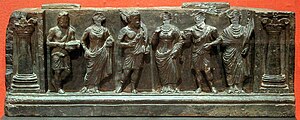Stair riser


A stair riser is the near-vertical element in a set of stairs, forming the space between a step and the next. It is often slightly inclined from the vertical so that its top is closer than its base to the person climbing the stairs. The horizontal edge of the stair is called nosing, whereas the surface on which a person's whole foot makes contact is called the tread.
Gandharan stair risers
Decorated stair risers were used extensively in the Greco-Buddhist art of Gandhara, to form the pedestal to small devotional stupas. They were usually adorned with friezes, fantastic animals and decorations.
A flight of stairs with decorated stair risers from the Chakhil-i-Ghoundi Stupa has been almost fully restored and can now be seen at the Guimet Museum in Paris.
Archaeological research by the Italian IsMEO at the Butkara Stupa suggests that small decorative stairs were adjoined to Buddhist stupas at the time of the Indo-Greek Kingdom, and that they were decorated with Buddhist scenes.

